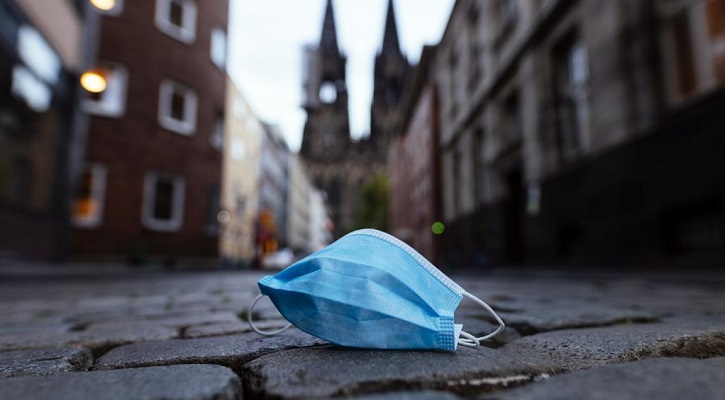
Coronavirus Second Wave? Why Cases Increase
- Lisa Lockerd Maragakis, M.D., M.P.H.
- December 24, 2020
When the coronavirus pandemic began early in 2020, experts wondered if there would be waves of cases, a pattern seen in other virus pandemics. The overall pattern so far has been one of increasing cases of COVID-19, with a surge in the summer and a larger one in the fall. Some locations that saw a high number of coronavirus infections early on, followed by a decline, are having a “second wave” of increased cases.
What will the future hold? Lisa Maragakis, M.D., M.P.H., an infectious disease specialist at Johns Hopkins Medicine, sheds light on what we know now about COVID-19 in communities and why the numbers of infections increase during certain times.
What causes a spike in coronavirus cases?
Human behavior is the major factor. State and local governments, as well as individual people, differ in their response to the pandemic. Some follow COVID-19 precautions, such as physical distancing, hand-washing and mask-wearing. Others are not as prescriptive in requiring these measures or in restricting certain high risk activities.
Read More : Why You Should Add Dragon Fruit to Your Diet ?
In some cities, towns and communities, public places are closed or practicing limitations (such as how many people are allowed inside at one time); others are operating normally. Some government and community leaders encourage or even mandate mask wearing and physical distancing in public areas. Others say it is a matter of personal choice.
However, the relationship between those precautions and cases of COVID-19 is clear: In areas where fewer people are wearing masks and more are gathering indoors to eat, drink, observe religious practices, celebrate and socialize, even with family, cases are on the rise.
Also, places where people live or work closely together (multigenerational households, long term care facilities, prisons and some types of businesses) have also tended to see more spread of the coronavirus. Coronavirus outbreaks at nursing homes and “superspreader” events gatherings of people where one infected person or more transmits the virus to many others continue to occur.
Are the spikes in coronavirus cases due to more coronavirus testing?
No. During a surge, the actual number of people getting sick with the coronavirus is increasing. We know this because in addition to positive COVID-19 tests, the number of symptomatic people, hospitalizations and later, deaths, follows the same pattern.
“Reopening” and Coronavirus Spikes : As communities began to reopen bars, restaurants and stores during the spring and summer of 2020, people were understandably eager to be able to go out and resume some of their regular activities. But the number of people infected with the coronavirus was still high in many areas, and transmission of the virus was easily rekindled once people increased their activities and contact with each other. Medical experts urged reopening communities to continue diligent COVID-19 precautions, including physical distancing, hand-washing and mask-wearing, and monitoring for symptoms. Unfortunately, the combination of reopening and lapses in these infection prevention efforts has caused the number of coronavirus infections to rise again.
Read More : Relationship Between Coronavirus, Nutrition and the Immune System
Tracking Coronavirus Surges : There is a delay between a policy change such as reopening businesses or relaxing occupancy limits in a community and when the effects of this change show up in the COVID-19 data. An increase in the number of COVID-19 cases or hospitalizations will not be seen a week or even two weeks later. It seems to take much longer, perhaps as many as six to eight weeks, for effects of a policy or widespread behavior change to appear in the population-level data.
When a person is exposed to the coronavirus, it can take up to two weeks before they become sick enough to go to the doctor, get tested and have their case counted in the data. It takes even more time for additional people to become ill after being exposed to that person, and so on. Several cycles of infection must occur before a noticeable increase shows in the data that public health officials use to track the pandemic.
So when an area relaxes precautions, the effects of that change will take a month or more to be seen. Of course, surges also depend on the behaviors of people when they start moving around more. If everyone continues to wear masks, wash their hands and practice social distancing, reopening will have a much lower impact on transmission of the virus than in communities where people do not continue these safety precautions on a widespread basis.
Is COVID-19 worse in the fall and winter?
In the beginning of the pandemic, some people wondered: Will the coronavirus go away in the summer? Unfortunately, a substantial spike during the hot summer months in the U.S. made it clear that this was not the case. Other respiratory illnesses, like colds and influenza (flu), are more common in the colder months. Now that fall is here, we are seeing a dramatic increase in COVID-19 across the U.S. In colder months, people gather indoors and this is a risk for further transmission of the virus.
Why are experts concerned about future spikes of the coronavirus or a second wave in some areas?
When the coronavirus first appeared in the U.S. in early 2020, it started with a very small number of infected people, so it took longer to spread. Now that the disease is widely distributed, with many unknowing coronavirus carriers in many different areas of the country, the risk of transmission is widespread. Fall and winter in the Northern Hemisphere means inclement weather in many areas, with more people spending time indoors. Several holidays take place around the end of the calendar year, and people who celebrate them want to gather, travel, and visit friends and family. Also, after many months of canceled activities, economic challenges and stress, people are frustrated and tired of taking coronavirus precautions. All these are factors that are driving surges and spikes in COVID-19 cases.
Read More : How to Eat Dragon Fruit ?
What is herd immunity from the coronavirus?
Herd immunity is a public health term that refers to the fact that, when enough people in a community have immunity from a disease, the community is protected from outbreaks of that disease. Infectious disease experts at The Johns Hopkins University explain that about 70% of the population needs to be immune to this coronavirus before herd immunity can work. People might be immune from the coronavirus, at least for a while, if they have already had it, but we don’t know this yet. A widely available, safe and effective vaccine may not be available for months.
Without a vaccine, most doctors and scientists agree that a herd immunity approach of letting the virus “take its course” is not acceptable. Letting the coronavirus circulate freely among the public would result in hundreds of thousands of deaths and millions more people left with lasting lung, heart, brain or kidney damage.
Researchers are currently trying to determine if, and for how long, people are immune from the coronavirus after recovering from COVID-19. If it turns out that immunity only lasts for a while, people could get COVID-19 again, resulting in even more death and disability. Preparing for a Spike or Second Wave of Coronavirus in Your Area Doctors, clinics and hospitals recognize that more COVID-19 surges are likely to occur. They are working with manufacturers to stock up on equipment, and they are continuing their policies for protecting patients and staff members.
Here’s what you can do now:
- Continue to practice COVID-19 precautions, such as physical distancing, hand-washing and mask-wearing.
Read More : Is Dried Fruit Good or Bad?
- Stay in touch with local health authorities, who can provide information if COVID-19 cases begin to increase in your city or town.
- Make sure your household maintains two weeks’ worth of food, prescription medicines and supplies.
- Work with your doctor to ensure that everyone in your household, especially children, is up to date on vaccines, including this year’s flu shot.





